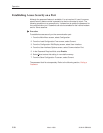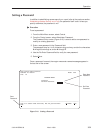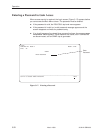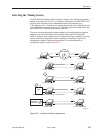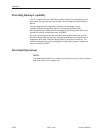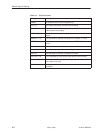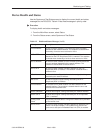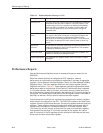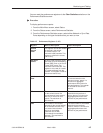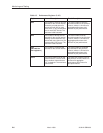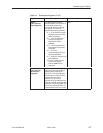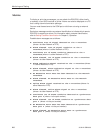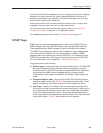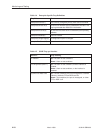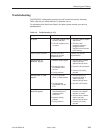
Monitoring and Testing
4-4
3162-A2-GB20-30
March 1999
Table 4-2. Health and Status Messages (2 of 2)
Message Description
EER at Port
n
The error rate of the received signal has exceeded the configured
threshold for data port Port
n
(where
n
is the port number). This
condition only occurs if the synchronous data port’s Embedded
Data Link (EDL) is enabled. The condition is cleared when the
error rate falls below the synchronous data port’s configured
threshold value.
Network Com Link
Down
The network communication link is in a down state. This condition
only occurs if the COM or AUX port is configured for Mgmt, and
communication between the management system and the
DSU/CSU is not currently possible for this port. For the AUX port,
this condition is detected only when a device reset or power-up
occurs.
Device Fail
xxxxxxxx
An internal error has been detected by the operating software. An
8-digit code appears for use by service personnel. The condition
is cleared by resetting the device.
Download Failed A download attempt was interrupted and failed to complete. The
condition is cleared by resetting the device.
System Operational This message only appears if there are no valid alarm or status
messages.
Performance Reports
Use the Performance Statistics screen to access performance reports for the
DSU/CSU.
When the network interface is configured for ESF operation, network
performance is continuously monitored and maintained in two sets of aggregate
registers: Carrier Network Interface Registers (Telco) and User Network Interface
Registers (User). The User registers contain an extra status register (Status).
Registers are listed in Table 4-3. These registers are status registers that collect
performance data for the previous 24-hour period. Performance data is updated
in 15-minute intervals. After 15 minutes, the current interval is rolled over into a
set of accumulator registers that represent the previous 96 15-minute intervals for
the register. An interval total of how many of the 96 registers contain valid data is
also kept, as well as a 24-hour total for each accumulator register.
Port performance is continuously monitored and maintained in memory registers
when the port is configured to use EDL. The DSU/CSU maintains two sets of port
registers for each synchronous data port: far-end port registers and near-end port
registers. These registers are status registers that collect performance data for
the previous 8-hour period. Port data is updated in 15-minute intervals. After
15 minutes, the current interval is rolled over into a set of accumulator registers
that represent the previous 32 15-minute intervals for the register. An interval
total of how many of the 32 registers contain valid data is also kept, as well as a
8-hour total for each accumulator register.



